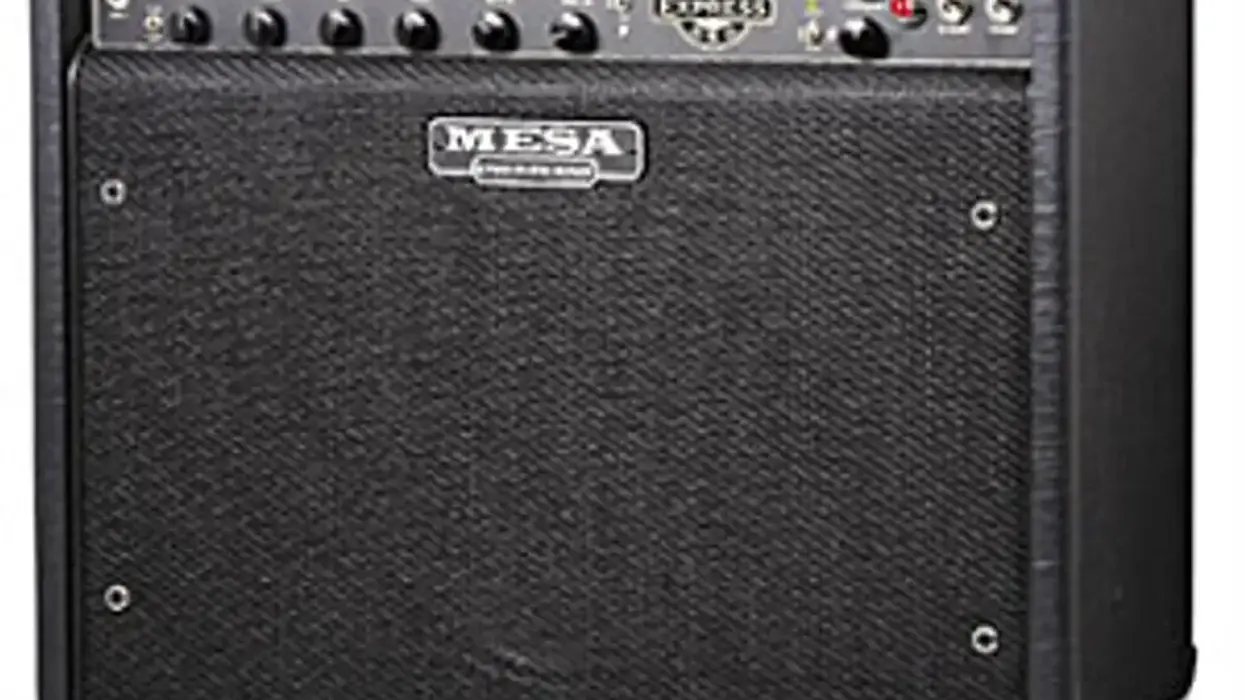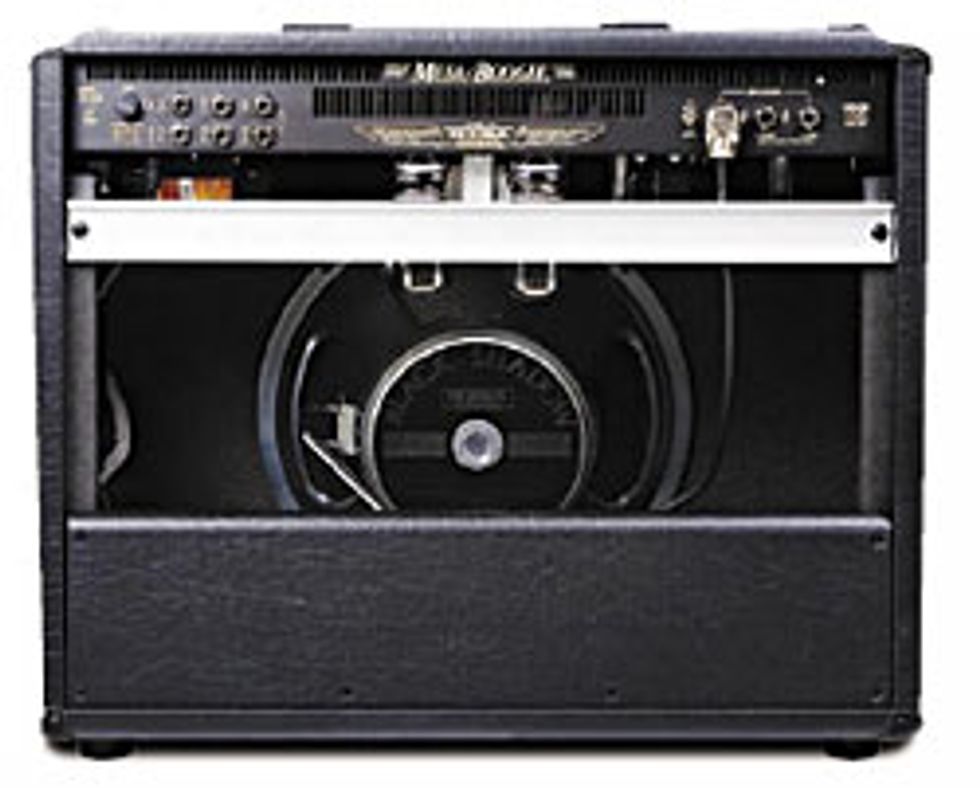Mesa Boogie recently added the Express
series of amplifiers to its vast line of tone
generators. The Express is offered up in
two formats to meet the musical tastes of
players of any genre. The 5:25 features two
EL84 power tubes and a smaller bottle
design that lends itself to the early breakup
and warmth heard in many vintage
British amplifiers. Our review model, the
5:50, features a duet of 6L6 power tubes.
If you’re not familiar with 6L6s, they lend
themselves to nice, sparkling clean tones
with a distinct, rich bottom end (think early
Fender). The 6L6 also comes across as
smooth in high gain situations and is definitely
one of my personal favorites.
The Express features Mesa’s Duo-Class
power switching circuit. The switching circuit
allows the player to choose between
Class A/B at 50 watts or Class A at five
watts. Peter Stroud, musical director and
guitarist for Sheryl Crow, PG columnist and
tone chaser extraordinaire, shed some light
on this subject and put it into terms that
are easy to understand: “When the amplifier
is in Class A mode, it is being pushed
much harder – think of it as the power
section on ten, full throttle – providing
more break-up, midrange and sag, which
is great for that vintage, bluesy rock vibe.
In A/B mode the power section provides
much more headroom, producing tighter
low-end sounds and a more prominent
top-end.” It’s a great design, and Mesa is
well-known for inventing this dual class
power section.
Out of the gate, the price of admission
on the Express 5:50 is justified by its
incredible flexibility and ease of navigation.
The 5:50 offers the player two separate
channels, each with two modes and independent
EQ. Channel 1 provides Clean and
Crunch while Channel 2 provides Blues and
Burn. Other features include a tube-driven
reverb and separate, footswitchable Contour
knobs for each channel.
“Although Channel 2 Blues was intended for moderate gain,
I found it to be my favorite tone center for full-on, smooth
distortion rhythm and lead work. This channel picks up
where Channel 1 leaves off; great blues tones are to be found
with the Contour disengaged in Class A mode.”
For my test drive, I used a Gibson Les
Paul BFG loaded with a Seymour Duncan
Custom Shop ‘78 model humbucker in the
bridge position and the stock P-90 up front.
Channeling It
I started with Channel 1’s clean setting
to get comfortable. Each channel
provides six knobs: Gain, Treble, Mid,
Bass, Reverb and Master Volume. In A/B
mode I was able to get some very pleasing
clean tones with decent headroom.
When I switched down to five watts, the
amp was absolutely beautiful and really
opened up, becoming very expressive
and making even order harmonics more
prevalent – these are the natural harmonics
that make an amp sound great, giving
chords and single notes rich, secondary
overtones. What’s killer about this channel
is when it’s pushed, by cranking up
the gain and rolling up your guitar’s volume
knob, you’ll hear some awesome,
fuzzified, distorted clipping sounds. Roll
down your guitar’s volume knob and
you’re instantly back to clean.
The crunch setting on Channel 1 was
most impressive to me in full power A/B
mode. I was able to get some thick, bold
distortion sounds. I first thought of this
amp as a low-powered vintage affair, but
I suddenly found myself in a dropped
tuning, ripping out aggressive higher-gain
rhythms. The low-end wasn’t extremely
tight – instead it was a little more organic
and somewhat spongy. This seems to be
a signature quality in most
Boogie amps – some folks
will like it, some won’t.
I was really knocked out by
the amp’s versatility when
I started messing with the
Contour. The Contour knob
allows the player to V-scoop
the EQ to their heart’s content
in any channel, and by scooping
just past the point of the
amp’s standard midrange
voice, I found fluid lead tones
with plenty of sustain.
Before moving on to Channel 2, I experimented
with the tube-driven reverb. I’m
generally not big on using reverb, but this
had a natural, organic feel. You could certainly
tell that there was a tube behind it
and it was sweet and transparent when
properly adjusted. You can adjust its level
with the knob on the faceplate and bypass
or engage it with the included Express
5:50 footswitch.
Although Channel 2 Blues was intended for
moderate gain, I found it to be my favorite
tone center for full-on, smooth distortion
rhythm and lead work. This channel picks
up where Channel 1 leaves off; great blues
tones are to be found with the Contour
disengaged in Class A mode. Burn is over
the top, just as advertised. By placing the
Contour knob in an extreme setting with
the amp in full-power Class A/B mode,
this channel was capable of venturing into
Metallica, Dimebag or similar territory with
no problems.
The Final Mojo
The Express 5:50 speaks in a variety of
voices and sounds great doing it. The low-powered,
old school tones were extremely
convincing and the A/B full-powered gain
sounds were huge. You could spend hours
dialing in variations, yet the amp still feels
simple and thoughtfully designed. Its variable
power makes it perfect for home
recording situations, but the amp will shine
in studio and live applications as well. If you
want to cover a lot of ground with speed,
ease and quality tone, this is a winner.
Mesa Boogie
1x12 $1199
2x12 $1299
Our expert has stated his case,
now we want to hear yours. Log on and share your
comments and ratings.









![Rig Rundown: Russian Circles’ Mike Sullivan [2025]](https://www.premierguitar.com/media-library/youtube.jpg?id=62303631&width=1245&height=700&quality=70&coordinates=0%2C0%2C0%2C0)












